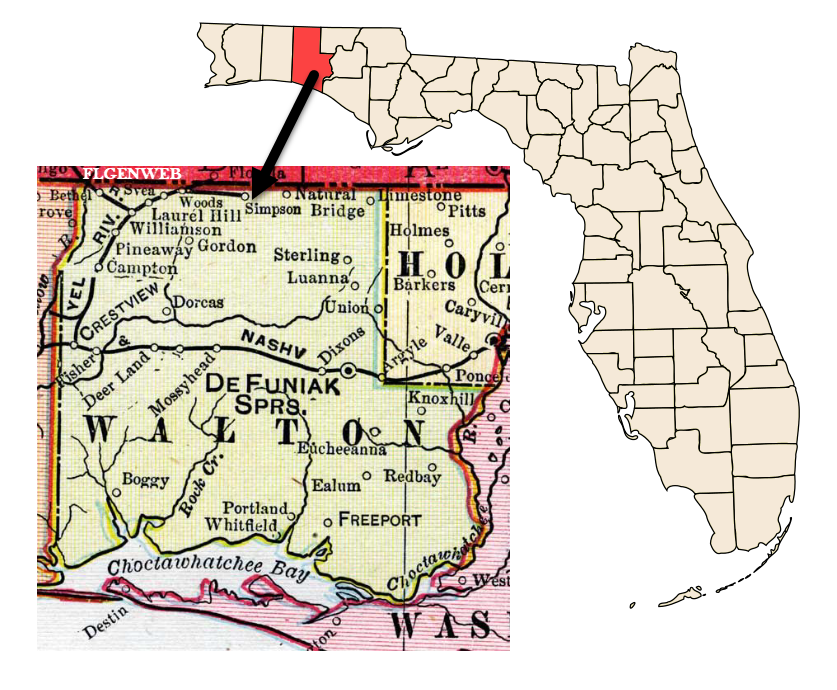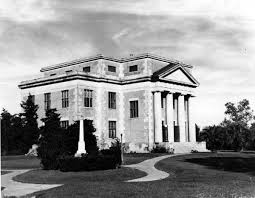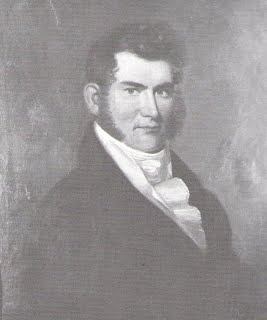
|
Home
| Archives
| Biographies | Books
| Cemeteries
| Census
| Churches
| Cities
| History
| Libraries Maps | Military | Miscellaneous | Schools | Vital Records | Volunteer |
|
| State Coordinator: Jeff
Kemp |
Assistant State Coordinator -
Tricia Aanderud
County Coordinator - Vacant |
|
Walton County is a county located
in the state of Florida. As of 2000, the population was
40,601. The US Census Bureau 2005 estimate for the county is
50,324. Its county seat is Defuniak Springs, Florida.
The county is home to the highest point in Florida: Britton Hill, at
345 feet (105 m).
Walton County was organized by the United States in 1824. It was named for Colonel George Walton, Jr.,
secretary of the Florida Territory from 1821 to 1826. Walton, the son of George Walton, a signer of the
Declaration of Independence, was born 15 August 1786 in Augusta, Georgia, and died
20 March 1859 in Petersburg, Virginia.

Between 1763 and 1783 the territory that has since become Walton County was part of the colony of British West Florida. During this time British settlers permanently settled in the area, becoming the first English-speaking people to permanently reside in what is now Walton County. During this period Scottish settlers migrated from the back country of the Carolinas and settled in the Defuniak Springs area while English settlers, most of whom were either farmers or fishermen, settled in the southern portion of the county by the sea, settling throughout the area that has since become Santa Rosa Beach, Sandestin, Miramar Beach, Point Washington, Seaside and Topsail Hill Preserve State Park and Point Washington State Forest.
While the Scottish settlers had come from a recently established Scottish-majority settlement in North Carolina, the English settlers came largely from the English regions of Norfolk, Dorset and the western half of Sussex. Both the Scots village in the northern portion of the county and the English community along the coast were largely self-contained and had economies that were entirely operational without external trade, as all products in use were made within the two respective communities, and the only external trade was between the Scots in Defuniak Springs and the English farmers/fishermen by the coast.
Neither community exported the goods they produced for profit, nor did they have any imported goods at all as both communities relied on self-produced subsistence agriculture.

The original settlements were in the Euchee (Yuchi) Valley, near the landing on the Choctawhatchee River that was maintained by a mixed-race Yuchi named Sam Story, whose mother was Yuchi and father was an early Scots trader in the area. The settlers founded one of the first Presbyterian churches in Northwest Florida. It is still an operating parish and has a historical cemetery.
When the Spanish regained control of Florida in 1783, roughly two thirds of the British settlers in Pensacola left the colony to find permanent habitation elsewhere, including in the Bahamas and Bermuda, however none of the English or Scottish settlers in what has since become Walton County left with them.
The Spanish came to regard the English and Scottish settlers in what has since become Walton County as "stubborn" and "ungovernable" as the Spanish were unable to make them obey Spanish law. They unanimously refused to convert to Catholicism, despite the fact that Spanish law said they were only allowed to remain in Florida if they did so and the Spanish were unable to compel them to pay taxes to the local Spanish government.
As settlers from the newly created United States of America began migrating into north Florida the English and Scottish settlers in what has since become Walton County became gradually absorbed into this community, which would subsequently become the majority population in North Florida.

Walton County was created in 1824. It was named for George Walton, Secretary of the Florida territory from 1821 to 1826. (Shown in figure to the right.)
In 1951, Mossy Head became the interchange point for a base railroad constructed between the Louisville and Nashville Railroad and Eglin Air Force Base, located partially in Walton County. The line operated until the early 1980s, nd a short section on the north end of the alignment still exists for rail shipments.
Source: Wikipedia